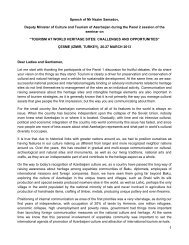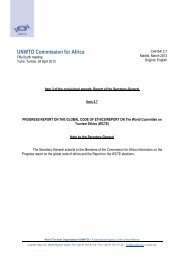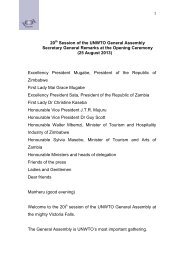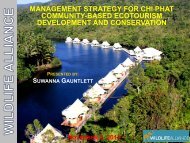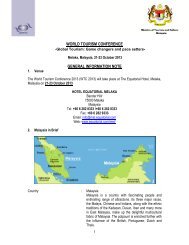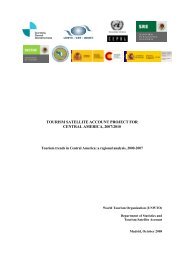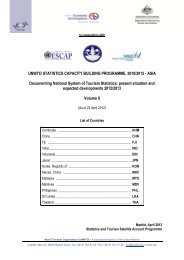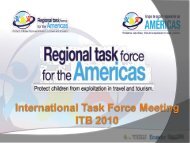A Manual for Water and Waste Management - World Tourism ...
A Manual for Water and Waste Management - World Tourism ...
A Manual for Water and Waste Management - World Tourism ...
You also want an ePaper? Increase the reach of your titles
YUMPU automatically turns print PDFs into web optimized ePapers that Google loves.
Case Study: Minneapolis City Center Marriot Hotel - Minnesota, USA<br />
The 538-room Minneapolis City Center Marriot Hotel, Minnesota inaugurated laundry gray<br />
water <strong>and</strong> cold water reuse systems. The gray water reuse system obtains the last rinse<br />
water from one wash load, filters <strong>and</strong> transfers it to a holding tank where it is heated to 140 0 F<br />
using a steam heat exchanger. The gray water is then used as first wash water <strong>for</strong> the next<br />
wash load.<br />
The cold water reuse system obtains water from the discharge of water-cooled condensers,<br />
water-cooled heat pumps <strong>and</strong> heat exchanger on the dry cleaning machine. The water is<br />
held in a cold water storage tank <strong>and</strong> used as a cold water supply <strong>for</strong> the washing machines.<br />
Both these systems allow water to be used twice be<strong>for</strong>e being discharged.<br />
Additional in<strong>for</strong>mation: Ms. Barabara Brodell, E-mail: barbara.brodell@mariott.com<br />
Reuse takes place when water or wastewater is used again in a facility be<strong>for</strong>e<br />
discharge into a treatment system (Figure 8). Reclamation is the process of treating<br />
wastewater to achieve a certain quality of water which can be reused. These<br />
commonly adopted water conservation techniques require technical skill <strong>and</strong> expertise;<br />
the technology is universally available <strong>and</strong> widely accepted.<br />
Figure 8: <strong>Waste</strong>water Reuse within a Tourist Facility<br />
An important step in successful wastewater reclamation <strong>and</strong> reuse is source<br />
separation. <strong>Waste</strong>water, generated from various sources, has different characteristics<br />
<strong>and</strong> potential reuse capabilities <strong>and</strong> should be separated into different streams with<br />
separate collection tanks <strong>for</strong> each source of wastewater generated. <strong>Waste</strong>water can be<br />
separated in the following ways:<br />
<strong>Waste</strong>water from bathrooms, sinks <strong>and</strong> kitchens has less toxicity, good reuse<br />
potential, requires minimal treatment <strong>and</strong> can be separated into one stream.<br />
<strong>Waste</strong>water from toilets <strong>and</strong> laundries contains more toxicity, requires treatment<br />
prior to reuse <strong>and</strong> can be separated as another stream.<br />
In an existing facility this kind of separation is difficult <strong>and</strong> requires major plumbing <strong>and</strong><br />
structural retrofitting. When designing a new facility this type of separation can be seen<br />
as cost effective.<br />
30





